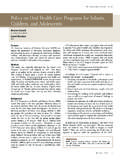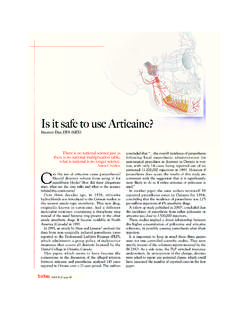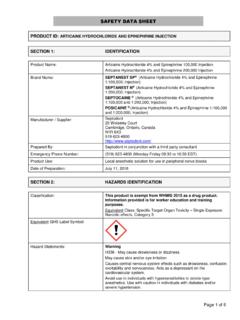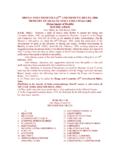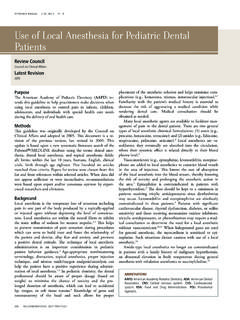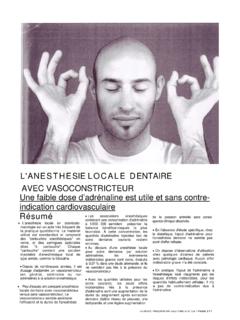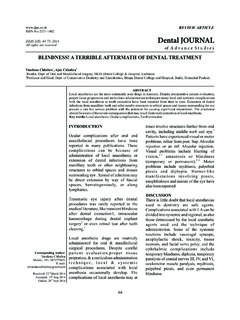Transcription of The effectiveness of mandibular infiltration …
1 Theeffectivenessof mandibularinfiltration comparedto mandibular block anesthesia in treating primarymolarsin children Constantine J. Oulis, DDS, MSGeorgeP. Vadiakas, DDS, MSAspa Vasilopoulou, DDS. Abstract comfortable numbfeeling last long after the end of den- tal treatment, often resulting in lip or tonguebiting. Fur- Mandibularinfiltration has been routinely avoided in thermore, a successful mandibular block involves a de- treating mandibular molars because of its questionable gree of difficulty I that makesthe injection stressful for purposeof our investigation was to deter- both the clinician and the patient. mine the effectiveness of mandibularinfiltration compared Investigators have looked at alternative techniques. with mandibularblock in treating primarymolarsin chil- Periodontal ligament injection has been suggested as dren, andto relate the effectivenessto ageandtype of treat- an alternative to mandibular block. 2 This technique is ment study population consisted of 89 co- simple and seems to provide the patient with adequate operativechildren, 3 to 9 years old, requiringthe sametype pain control, without the extended period of postop- of treatment on contralateral mandibularmolars.
2 The half- erative anesthesia. 3 However,the potentially damag- mouthstudy design was used. Dental proceduresincluded class I andII amalgam restorations, stainless steel crowns, ing effect of an anesthetic solution expressed under high pressure on the amelogenesis of the permanent formocresol pulpotomies, and extractions. Evaluations of tooth is a concern in treating primary teeth. 4 This side pain and behavior for each anesthesia technique and type effect and the need for a special syringe makesit less of treatment were madeusing sounds, motor, and ocular attractive to the pediatric dentist. changes indicating pain and the Frankl Behavior Rating infiltration anesthesia has been used successfully to Scale. Evaluations were made upon probing, rubber dam restore maxillary teeth but has been avoided in the placement, and during tooth preparation and extraction. mandibular molar regions because of denser bone that No statistically significant difference was found between does not allow adequate dissemination of the anes- the two anesthetic techniques for either behavioror pain thetic.
3 Recently, two studies investigated the effective- whenperformingamalgamor stainless steel crownresto- ness of mandibular infiltration in restoring primary rations (P = ). Mandibularinfiltration was less effec- molars in children. Dudkiewiczet al. 5 restored 84 man- tive than mandibularblock for pulpotomyand extraction (P = ). Nosignificant relationship to age as determined dibular primary molars under infiltration anesthesia in 50 children ranging in age from 4 to 10 years. Articaine by primaryor mixeddentition, for effectiveness was no- hydrochloride 4%was used as the anesthetic solution, ticed. (Pediatr Dent 18:301-5, 1996). and each injection was followed by a 10-min waiting period before undertaking operative dentistry. The he mandibularblock is the local anesthesia tech- T nique of choice when treating mandibular pri- mary or permanent molars. Simultaneous lingual authors, using clinical assessment criteria, concluded that infiltration anesthesia was successful in all cases.
4 Wrightet al. 6 also studied the effectiveness of infiltra- and occasional long buccal nerve block whena mandibu- tion anesthesia in 66 children, 42-78 months old, who lar block is administered, result in anesthetizing the re- required conventional operative dentistry in the first spective half of the tongue and lower lip. Profundity of or second mandibular primary molars. Three types of anesthesia has been the primary advantage of this tech- local anesthetics were used, mepivacaine hydrochlo- nique, while anesthesia of all the molars, premolars, and ride 2%, prilocaine hydrochloride 4%, and articaine canines on the side injected allows for treatment of mul- hydrochloride 4%. Operative procedures were video- tiple teeth of the same quadrant at one appointment. A taped, and assessment of comfort and behavior was numberof disadvantages also have been associated with made using the SEMscale and the Frankl behavioral this technique. The duration of anesthesia makesthe un- scale.
5 Sixty-five percent of the subjects experienced Pediatric Dentistry- 18:4,1996 American Academy of PediatricDentistry301. little or no pain during cavity preparation. Profundity Treatment was discontinued if the child expressed of anesthesia was not significantly related to the three signs of pain and was resumed after a mandibular variables examined:tooth location, chronologic age, or block was given. In each case, once the rater evaluated anesthetic agent. However,neither study investigated presence of pain during a dental procedure, he imme- the effectiveness of mandibularinfiltration in compari- diately announcedit and the child was crossed over to son to an established anesthesia technique such as the a mandibular block. mandibular block was performed mandibular block in treating primary molars. using the conventional technique and ml of anes- The purpose of our investigation was to determine thetic. A long buccal nerve injection also was adminis- the effectiveness of mandibular infiltration compared tered in all subjects as an adjunct to mandibular block with mandibular block in treating primary molars in to guarantee anesthesia of the buccal mucosa.
6 A #30. children and relate it to the type of treatment per- gauge needle, 25 mmlong (Hypo*, short, Smith &. formed. An attempt was made to relate the effective- NephewInc, Franklin Park, IL) was used for the block ness of anesthesia established to patients' ages. injections. Dental procedures included class I and II amalgam Methods and materials restorations, stainless steel crowns (SSC), formocresol The study sample consisted of 89 children, age 3-9 pulpotomies, and extractions. Pulpotomies and extrac- years, whocame to a private practice seeking dental tions always followed preparation of proximal teeth for treatment. All children were screened at the first visit an amalgamor SSCrestoration. All subjects participat- for admission to the study, and informed consent was ing in the study were treated by the same operator. obtained from each child's parent or guardian. To be effectiveness of each anesthesia technique was as- included in the study the children had to meet the fol- sessed by evaluating the presence or absence of pain lowingcriteria: while probing the gingivae, during placement of the 1.
7 Werehealthy, with no knownallergies to medi- rubber dam, during use of high- and slow-speed hand- cations or local anesthetic piece, and during extraction. A separate evaluation was 2. Werecooperative at the initial visit made during removal of the coronal pulp during a 3. Had carious lesions in primary molars on both pulpotomy procedure. No evaluations were made for sides of the mandible requiring the same type the restoration following a pulpotomy. Any sign of of treatment on contralateral mandibular molars discomfort indicating pain upon assessment of each 4. Required treatment of at least one maxillary evaluation interval was recorded as presence of pain, tooth. the procedure was discontinued, and the anesthesia All children had maxillary teeth treated prior to technique evaluated as inadequate. Signs of discomfort mandibular teeth to allow for adjustment to dental included hand and body tension, eye movements in- environment and to confirm their cooperative behav- dicating pain, verbal complaints, tears, and hand and ior.
8 Treatment in the maxilla included dental proce- body observational scale to quantitate dures such as amalgamrestorations, stainless steel discomfort was used. Either there was discomfort or crowns, pulpotomies, and extractions. not and that was translated to presence or absence of Subjects received an infiltration on one side of the pain. The child's behavior at the stages described above mandible and a block on the other. Treatment in the also was assessed by using the Frankl behavior rating mandible was completed in two visits -- one side at scale. 7 Assessment of both pain and behavior were each visit. Selection of the side to receive an infiltration madeseparately for each tooth treated. or a block and the visit was made randomly. For the During the study, both anesthesia techniques were infiltration visit, the procedure was as follows. Follow- evaluated blindly by a single rater who was not the ing a 1-min application of topical anesthetic (Ben- operator. A pilot study was conducted in a group of 10.)
9 Zocaine 10%, Sultan Dental Products, Englewood, NJ) children to familiarize the rater with the methodology, on dry mucosa, ml of lidocaine hydrochloride 2% and treatment in both sides of the mandible was vid- containing epinephrine 1:100,000 (Xylestesin -- Forte, eotaped to establish intrarater reliability. During the Espe Seefeld/Oberbay, Germany)was infiltrated in the pilot study, evaluations on pain and behavior were mucobuccalfold betweenthe roots of the first and sec- made by the rater and an experienced pediatric den- ond primary molars and in the mesial and distal pa- tist to establish inter-rater reliability. pillae of the teeth to be treated. The total amountof Thez test wasusedfor statistical analysis of pain evalu- anesthetic administered was consistent for all patients. ation while the chi-square test of independencewas used A #30 gauge needle, 11 mmlong, (Adaptic, x-short, to analyze behavior. Fisher's exact test was used to de- Johnson & Johnson, Skillman, NJ), was used for all in- termine the association betweenpain and behavior.
10 Chi- filtration injections. A 5-minwaiting period elapsed be- square was performed with two degrees of freedom, and fore the teeth to be treated were probed buccally and the level of significance wasset at 95%for all tests. lingually to determine anesthesia. A rubber dam was then applied placing an Ivory 8A clamp on the second Results primary molar and treatment followed. A total of 89 children (42 males and 47 females) par- 302 American Academy of PediatricDentistry Pediatric Dentistry- 18:4,1996. ticipated in the study. During the pilot study, inter- and and behavior assessment for the two dentition groups, intrarater reliability were established and found to be relative to each type of dental procedure performed. A. 90 and 92%, respectively. No subjects dropped out of total of 102 amalgam restorations were completed in the study. first and second mandibular primary molars -- 61 in Subjects were placed into two groups according to primary and 41 in mixed dentition -- while 27 SSCs their dentition stage -- primary or mixed dentition.



